The basis of high-quality and high yield is laid at the end of the growing season and is highly dependent on the proper care of cherries in the fall. Only by taking into account natural needs, by warning possible problems, can health and proper development of the fruit tree be ensured. Therefore, autumn activities should be carried out steadily and correctly.
Table of contents
Goals for autumn cherry care
After the growth of the shoots is suspended in the cherry, the tree begins to gradually enter a period of rest and prepare for the next season. At this time, flower buds begin to be laid in the tree, the trunk and shoots are woody.
In addition, cherry need to lay enough nutrients for a painless way out of the state of rest. Therefore, the tree is particularly in need of autumn fertilizing with fertilizer and in water-recharge irrigation.
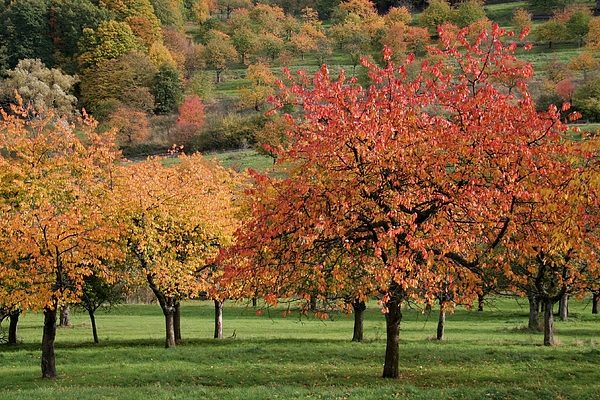
Another threat that warns cherries in the winter season fungal diseases. Basically, their spores fly to a tree in the fall, winter safely, and with a temperature higher than + 15 ° C they begin to actively develop. It is possible to fight with microorganisms only with the help of careful processing of the near-barrel circle and wood with fungicides.
In the autumn, the number of many pests reaches a maximum. Despite careful processing, insects can fly from other sites and lay eggs capable of hibernating. Therefore, prophylactic treatment with insecticides and a thorough inspection of the tree will be necessary.
Cherry is also in need of a protective shelter from rodents and frostbearing, weatherization of roots. It is important not to forget about the features of the winter season: squally winds and heavy rainfall. They often lead to cherry injuries. Any damage to the crown complicates the development of the tree after the start of sap flow and affect fruiting. This can be prevented with the help of preventive pruning.
Pruning a cherry in the fall
Pruning cherries at the end of the growing season, in addition to protection from natural factors, has another goal - thinning the crown. During the procedure, you must consider the type of cherry, pruning trees and bush plants are different. This is distinguished by the difference in fruiting: in bushy varieties, flower buds form on annual growths, on tree-like ones on bouquet branches.
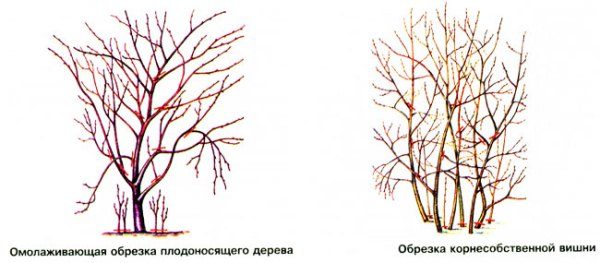
Pruning is carried out when the cherry enters a state of rest, at least 15 days before the first frost. Depending on the climatic zone, dates may begin from mid-September and last until the end of November. For the procedure you need to prepare sharp garden shears and garden var.
Bush cherry:
- removal of ½ of the branches exposed at the end;
- shortening of skeletal and semi-skeletal branches to lateral branching;
- removal of damaged and rotten branches.
Tree cherry:
- shortening the annual shoots by 1/3;
- shortening shoots more than 1.5 meters by 1/7;
- removal of drying side branches.
Regardless of the type of tree, you need to remove the branches: growing in the wrong direction, at an acute angle, intersecting with each other. Sections are made only above the kidney or on the annular flow. Wounds with a diameter of more than 1.5 cm are covered with a thin layer of garden pitch.
All removed remnants of branches, mummified fruits, fallen leaves should be burned. Pristvolny circle should be as clean as possible and ready for other preparatory activities for the winter.
Proper autumn care is the key to a good harvest.
Seasonal activities for the care of cherries should begin immediately after harvest, starting in August. This will help to properly allocate time for the phased processing of wood and preparation for winter.
Water recharge irrigation
In the absence of heavy rain moisture deficit occurs in the fall. This is a dangerous phenomenon during the autumn growth of the root system, which leads to the lack of development and death of certain areas. At the same time, cherries undergo a hardening period and after its completion it is severely damaged by frost.
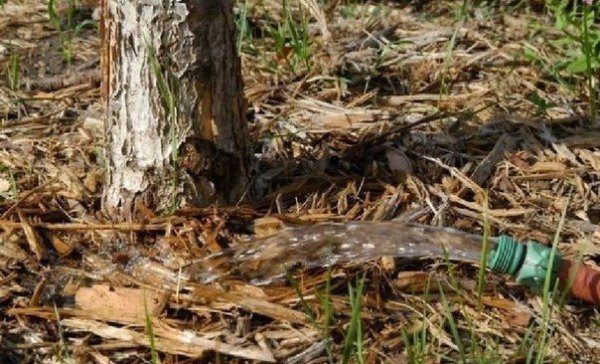
Water recharge irrigation should be carried out in the third decade of September. The rate of watering, depending on the size of the tree from 18 to 24 buckets of water. The procedure is excluded in the rainy season.
Fertilizer and dressing
The main elements required for cherries in the fall are phosphorus, potassium and calcium. Each of these minerals is an important participant in preparing the tree for the next season. From the wealth of these elements depends on the ovary of flowers, winter hardiness, resistance to diseases and the quality of fruiting trees, so the tree should be fed. How to fertilize fruit trees?
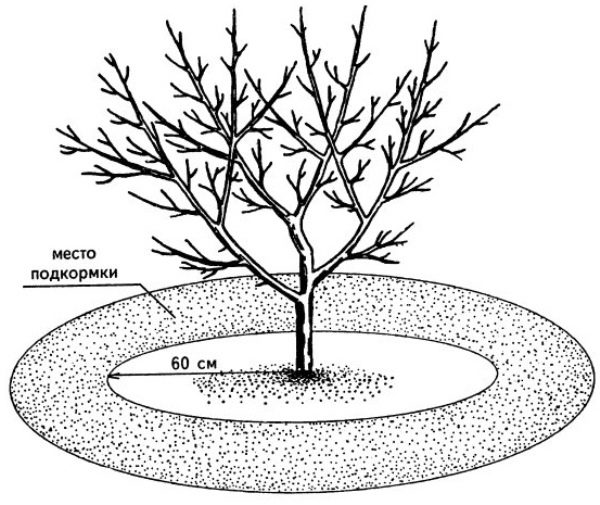
For feeding cherries in aqueous system make aqueous solutions:
- superphosphate (300g / 10 l);
- potassium chloride (150 g / 10l);
- sulfate, nitrate, calcium chloride (25g / 25g / 25g / 10l).
Pest and disease treatment
Autumn treatment against pests must begin with cleaning the trunk and branches from layers of moss, lichen and exfoliated parts of the bark. This can be done with a metal brush.
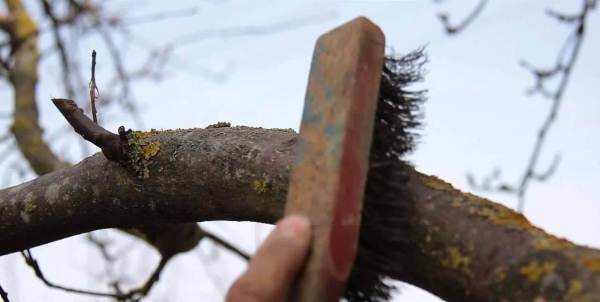
You also need to collect all plant residues from the circle of the trunk, while removing weeds.Often with this you can find areas with egg clutches that need to be destroyed manually.
If the number of pests does not exceed the established threshold, folk remedies are applied:
- ash-soap solution (400g / 50g / 10l);
- aqueous solution of birch tar (10 ml / 50g / 10l);
- means from camomile pharmaceutical, infused 12 hours (1kg / 10l).
With a strong defeat of cherry pests, the tree must be treated with chemicals: "Karbofos", "Aktellik", "Prestige", "Bankol".
Another important cherry processing fungicide spraying. Cherry is sprayed with 1% Bordeaux liquid. Consumption for young trees up to 2 liters, for plants over 6 years old up to 10 liters. Parallel processed and pristvolny circle.
Preparing for the winter
Winter cold can come suddenly and can destroy even the strongest tree. therefore cherries need to be prepared in advance when the ground begins to freeze, and the air temperature drops to the mark -10 ° C. In addition, rodents begin to experience a shortage of food and the bark of fruit trees during this period becomes the most attractive for them.
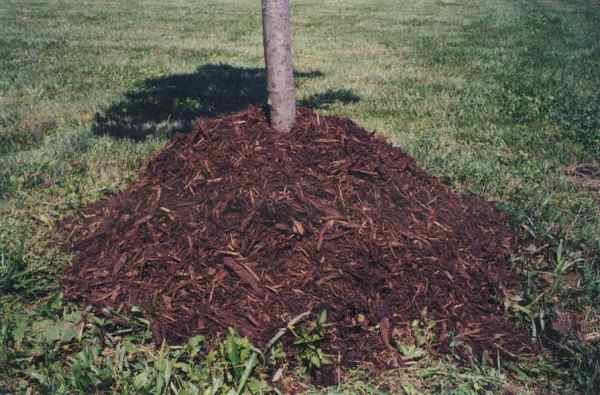
First of all, you need to protect the roots of cherries from the effects of frozen ground in the depths. Autumn rains strongly condense the soil of the circle of the trunk, displacing air from it, which contributes to the rapid freezing of the soil. In this case, mulching of the soil surface under the crown of cherries will help.. For this you can use any loose material: peat, leaves, sawdust.
Thoroughly cleaned boil needs to be protected from sunburn. To do this, whitewash. This can be done with synthetic BC-551 latexes or with the “Protection” agent. You can also make the mixture yourself.
Composition:
- lime 1 kg;
- clay 1 kg;
- mullein 0.5 kg;
- copper sulphate 300 g
Components need to be dissolved in water to the consistency of thick cream. Adding the fungicide will additionally create protection against fungal spores. The smell of mullein scare hares.For additional protection, the trunks of the tree are wrapped with breathable material and garden mesh..
It will be useful for you to know:
- How to plant a sweet cherry in the fall
- How to plant a plum in the fall
- Planting and care felt cherry
- Winter hardy varieties of pears for cultivation in Siberia
How to replant a tree?
In some cases, there is a need to transplant adult cherries to a new place in the garden. Given that the growing season of the tree starts early, it should be done in the fall. The best time for the event is the end of September or October.
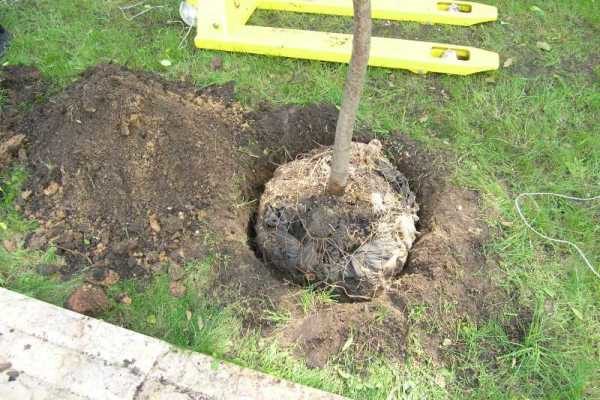
Stages of cherry transplant:
- trenching at a distance of 35-45 cm from the trunk at a depth of 35 cm;
- heavy spill soil inside the circle;
- definition of basic rootsholding the tree;
- root cutting on the outer border of the trench;
- stripping sections a knife.
After this, strong poles are placed under the released roots, take out the cherries and put them on the prepared material for transportation to the landing site.
The cherry is placed in a prepared pit, the diameter of which should be several centimeters larger than the root lump. Wherein it is important to spread the roots well so that they do not remain bent up. The tree is lightly shaken while the pit falls asleep to avoid the formation of voids.
When the pit is almost filled with soil, it must be well compacted. Do it in the direction from the edge of the pit to the center.The remaining voids supplement the soil, and the tree is watered with 6-8 buckets of water.
The main mistake gardeners - an attempt to transplant trees over 4 years old in a similar way. When digging in such a way, large trees lose their absorbent, fibrous roots, which immediately leads to death. For large trees requires preliminary preparation, and it begins in the previous season.
Stages of preparation for the year before landing:
- maximum thinning of the crown;
- trench formation at a distance of 80 cm from the shtamba 60 cm deep;
- cutting off the roots beyond the perimeter of the circle;
- cleaning of cuts and processing with garden pitch;
- the trench is filled with humus and plentifully watered.
The following year, the cherries are transplanted in the same way as younger trees.
Getting rid of sprouts
If the annual care for the cherry is unstable or completely absent, a large number of seedlings will be formed next to the mother plant. Cherry is gradually depleted and ceases to bear fruit.All this because abundant growth takes the main nutrients from the soil, and cherries are deficient in minerals, therefore such shoots need to be rooted out.
The only option to permanently get rid of the shoots that leads to the results is the manual removal method. It is important to do it right.
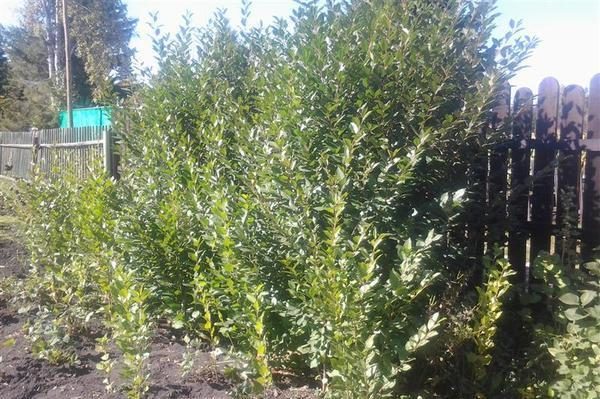
Stages of the procedure:
- removal of shoots immediately after the appearance;
- the formation of small holes near the roots and chopping off shoots shoots departing from it;
- processing of a place of a cut by garden pitch.
Any cuts are made with a sharp garden knife, leaving no hempfrom which new sprouts are quickly formed.
Significantly reduce the number of sprouts of permanent control over the tree trunk circle, the bone of each fallen fetus will undergo a winter stratification and will give a new shoot in the spring. Prevents sprawling neighborhood with a spreading tree, but in this case it will shade the cherry itself.
Cherries will enter each growing season with strong forces, and will delight you with a high yield only if you carefully care for the tree in autumn. Life expectancy, the quality of the fruit, the absence of disease initially depend on the varietal characteristics, but only a gardener can support them throughout the life of the fruit tree.
